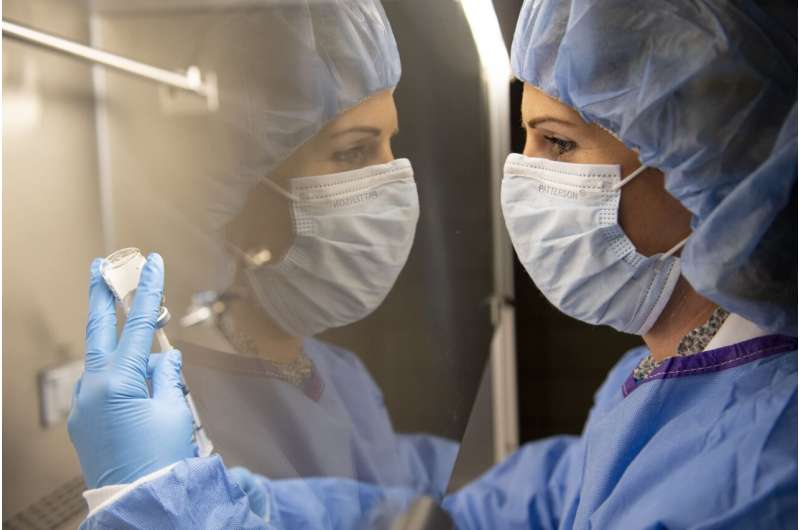This article has been reviewed according to Science X's editorial process and policies. Editors have highlighted the following attributes while ensuring the content's credibility:
fact-checked
trusted source
proofread
Ambitious goal to sequence RNA could boost US economy

A chemist who leads the University of Cincinnati's Office of Research is playing a role in a scientific undertaking to unlock the secrets of RNA.
The National Academies of Sciences, Engineering and Medicine have published a report that lays out an ambitious plan to sequence the molecules that play a crucial role in sharing genetic information between cells.
The report outlines the steps to create the technology and assemble the collective scientific resources needed to succeed within the next 15 years.
The project has been likened to the Human Genome Project, the massive 13-year effort completed in 2003 by scientists around the world to sequence human DNA. But Patrick Limbach, UC's vice president for research, said there is one important difference—sequencing RNA is much, much harder.
"It's a challenging undertaking," Limbach said.
Limbach serves on the National Academy of Sciences study committee that outlined the scope of the project.
"The Human Genome Project captured the imaginations of many people to understand who we are as human beings," Limbach said. "But DNA doesn't change all that much. RNA by comparison is dynamic. It's constantly being produced and degraded. And cells can modify the same RNA differently, which adds to the complexity of biological systems."
Limbach said studying DNA is like closely scrutinizing every detail of a photo. But studying RNA is like "trying to examine every frame of a movie while it's playing. It requires a different set of technologies."
Limbach is an Ohio Eminent Scholar and professor of chemistry in UC's College of Arts and Sciences. In his lab, he has been using tools such as mass spectrometry to study RNA. He holds two patents relating to his work in RNA analysis. His lab's work was cited 30 times in the recent National Academies' report.
"Presently, my lab is part of a multinational collaborative project that is trying to find some of the best operating principles to study RNA modifications," he said.
Sequencing RNA in all its many forms could benefit public health in profound ways.
The report titled "Charting a Future for Sequencing RNA and its Modifications" explains how RNA is "edited" and revised, giving rise to sometimes thousands of distinct RNA molecules for each gene. This complex system is essential in the growth and maintenance of cells. But breakdowns in RNA can also lead to a wide range of human diseases, from cancer and heart disease to neurological and autoimmune disorders.
"The basic tenet of molecular biology is that DNA creates RNA and RNA creates the proteins that our cells need," Limbach said. "So if RNA has errors or is misread or is not modified properly, it can make the wrong protein, leading to all kinds of diseases in human health."
The report outlines how the project could help improve the diagnosis and treatment of disease and identify more effective means to control harmful pathogens.
Most everyone is already familiar with one example of how scientists are harnessing the power of RNA in medicine. Both the Pfizer and Moderna vaccines use a type of RNA called mRNA to create antibodies against COVID-19. UC led the clinical trials for the Moderna vaccine in 2020.
University of Pennsylvania researchers Katalin Karikó and Drew Weissman were awarded a Nobel Prize for their groundbreaking work in RNA modification that led to the vaccine.
"Had they not already done the work they did on RNA modification, we might have been stuck with COVID vaccines that weren't nearly as effective," Limbach said. "The vaccines make our project much more accessible to the public to understand why scientists are interested in this."
At UC's Cancer Center, scientists are using similar technology to develop a vaccine to treat pancreatic cancer, a deadly disease that afflicts more than 66,000 people every year in the United States. The technology is giving new hope to patients fighting a disease that is fatal in 95% of cases.
But the mysteries of RNA hold untold other possibilities, from improving the yield on crops to creating more efficient renewable energy. And that has significant implications for national security, Limbach said.
The report estimates that improving our understanding of RNA modifications could boost the economy by $4 trillion per year.
"What we don't yet have is the technology the report is pushing for—the capability to take a single molecule of RNA and sequence it and all the modifications from one end to the other," Limbach said.
That will require a large upfront investment both in infrastructure and expertise. The report recommends ways to close the gap in tools and technology and public and private investment to accelerate innovation.
"You have to have the talent pipeline. Future generations will be the ones to solve these problems," he said.
This relatively new field of science also requires a more rigorous set of standards for preparing samples, sequencing, mapping and analysis to ensure reproducible results and access to data.
"If we follow the roadmap, we think it's doable in 15 years," Limbach said.
More information: Charting a Future for Sequencing RNA and Its Modifications, (2024)
Provided by University of Cincinnati



















